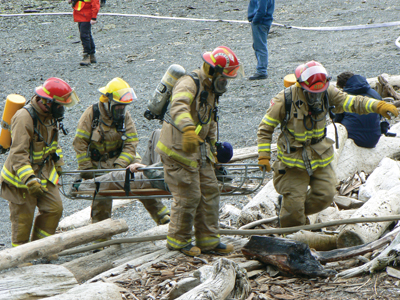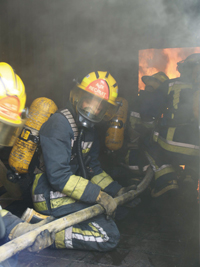
Association news
News
Moving Forward
When faced with a large and complex challenge it’s easy to find an excuse to ignore it.
April 23, 2010
By Karin Mark
When faced with a large and complex challenge it’s easy to find an excuse to ignore it.
 |
| British Columbia’s 350 fire departments have operated independently but are now working together to meet future challenges. Stakeholders agree that there has been no central leadership or direction to ensure co-ordination, co-operation and consistency in operations, training and services. Photo courtesy B.C. Fire Service Liaison Group |
Three years ago, representatives of British Columbia’s fire/rescue service could easily have employed the adage “If it ain’t broke, don’t fix it” when faced with the daunting task of determining how the 350 independent departments that provide fire, rescue and emergency services in B.C. must evolve to meet the challenges of the future.
After all, fires are still being extinguished, property is still being protected and lives are still being saved.
This may be true but in recent years it had become increasingly impossible to ignore the fact that B.C.’s fire/rescue service had not kept pace with changing public needs and expectations, operational demands and fiscal challenges.
“The last real official look at the fire/rescue service was 35 years ago,” said Fire Chiefs’ Association of B.C. President Stephen Gamble, who chaired the Fire Services Liaison Group (FSLG) that was tasked with determining how to modernize the service.
“The services we provide have really changed, as well as the expectations and the environment we work in. We need to change too.”
 |
| The Fire Service Liaison Group report includes 14 recommendations to modernize the fire service. Its top three challenges are funding, training and recruitment and retention. Photo courtesy B.C. Fire Service Liaison Group |
Funded by provincial and federal grants, the FSLG brought together key stakeholder groups with direct interests in the fire service, including local governments (via the Union of B.C. Municipalities and Local Government Management Association), as well as management and employee groups (the Fire Chiefs’ Association of B.C., the Fire Prevention Officers’ Association of B.C., the B.C. Fire Training Officers’ Association, the B.C. Professional Fire Fighters Association and the Volunteer Firefighters’ Association of B.C.). The Office of the Fire Commissioner was an ex-officio participant.
After more than two years of extensive research and discussion, the FSLG has released Public Safety in British Columbia: Transforming the Fire/Rescue Service, which includes 14 short-term and long-term recommendations (see sidebar page 24) that are intended to achieve the transformation required.
The report is in the hands of the provincial government for review but has already generated interest from fire service organizations in British Columbia and across the country.
“There are several recommendations that are not just B.C. issues,” Gamble noted. “We feel other provinces will find some value in the report.”
According to the report, one of the key challenges facing B.C.’s fire/rescue service is the fragmented manner in which it evolved. The approximately 350 departments collectively employ about 4,000 career firefighters and 10,000 volunteer firefighters. More than half are located in and managed by municipalities and regional districts while the rest operate in small, unincorporated communities under the direction of improvement districts or societies.
Over the years, these hundreds of departments each developed independently, with no central leadership or direction to ensure co-ordination, co-operation and consistency in operations, training and services. Attitudes and practices are entrenched, resources are limited and co-operation is poor.
However, in surveys conducted by the FSLG, fire departments and local governments across the province agreed on the top three challenges facing B.C.’s fire/rescue service:
- Training;
- Funding;
- Firefighter recruitment and retention.
- Drilling down further into the issues, the FSLG targeted the following key problems that are hindering the fire/rescue service:
- Responsibility for fire and rescue
- services is unclear;
- Governance of B.C.’s fire/rescue
- service is lacking;
- Gaps in services exist;
- There are no province-wide competency standards;
- Data is not available for effective
- decision making;
- Operational differences exist among various fire departments;
- No pro-active strategy exists to address budget pressures;
- And the volunteer sector is under heavy stress.
Gamble noted that development of the 14 recommendations to address these challenges required a level of co-operation that previously didn’t exist in B.C.’s fire/rescue service. Although critics had predicted infighting would derail the process, those involved were able to set aside any biases and work as a team for the common good.
It started with the development of a common vision for the fire/rescue service: “To have a competent level of fire and emergency services that is supported by sustainable resources for all residents of and visitors to the province of British Columbia.”
“We proved that we can work together,” Gamble said. “That kind of united thinking and co-operation was remarkable in itself.”
The new, collaborative attitude within B.C.’s fire/rescue service will certainly be needed in the months to come as the work begins to ensure the report is taken seriously and that its recommendations become reality.
“Ideally we’d like to have every one of the immediate priorities implemented right away, but realistically we know it will take some time,” Gamble said. “We do have a strategy and we look forward to working with the provincial government to do what is needed to improve public safety in our province.”
Public Safety in British Columbia: Transforming the Fire/Rescue Service is available for download in the public section of www.fcabc.bc.ca .
Transforming the fire service
The report’s 14 recommendations were divided into immediate and long-term priorities.
■ Immediate priorities to be addressed by the provincial government
- Establish a Fire Services Advisory Board – this single representative body would provide policy leadership and co-ordination for B.C.’s fire/rescue service. It would speak on behalf of the service, address issues and challenges, act on common issues and put forward initiatives to the provincial government. B.C.’s Fire Services Act provides for the creation of such a board.
- Broaden the mandate of the Office of the Fire Commissioner – update the mandate of the OFC to reflect the full range of services provided.
- Standardize competencies and training standards – clarify and specify training standards for the fire/rescue service (specifically interior fire fighting), to help ensure fire departments meet minimum competency and safety standards.
- Support training, recruitment and retention for volunteer departments – provide support for training, recruitment and retention for volunteer fire departments in small and rural communities to help these under-resourced departments meet recognized standards for firefighter training and maintain acceptable minimum staffing levels.
- Improve the fire investigation and inspection system – fund a joint study to improve these two critical fire prevention services.
- Identify and fill gaps in service coverage – initiate a study to clarify services and identify gaps in fire/rescue services; develop a joint strategy to address gaps in medical first responder coverage; make legislative changes to enable local governments to enact bylaws intended to improve public safety; implement a province-wide public fire education strategy.
■ Immediate priorities to be addressed by local government
- Investigate local and regional efficiencies – initiate reviews of department operations and services with the goal of achieving efficiencies, and seek regional efficiencies while reviewing services and service levels.
- Provide administrative and management support to volunteer departments – with support from Office of the Fire Commissioner, ensure volunteer departments have the necessary administrative and management support.
■ Long-term priorities to be addressed by the provincial government
- Establish local government responsibility for fire/rescue services – undertake initiatives to improve accountability and oversight of the fire/rescue service, including a transition plan to give local governments responsibility for all fire departments in their jurisdictions (except for private, federal or First Nation departments), and a requirement for local governments to file annual service plans for their fire departments.
- Update compensation agreements for services to provincial agencies – fund a joint study to review and update tariffs paid to fire departments for services provided to provincial agencies, and the requirement for departments to receive pre-authorization from the Provincial Emergency Program to be compensated for calls outside their service areas.
- Improve training opportunities – initiate projects intended to improve access to firefighter training and to provide leadership training for the fire/rescue service.
- Enforce competency, training and operating standards – initiate development of a strategy for improving firefighter competencies over an extended transition period, including a deadline for all volunteer firefighters to attain the basic fire fighting certificate, and mandatory fire department registration and certification.
- Research and develop best practices – research trends and issues, and develop, publish and promote best practices guidelines for fire and rescue services, including information specific to volunteer departments.
- Improve interoperability in the fire/rescue service – fund initiatives to promote greater interoperability, co-ordination and information sharing within the fire/rescue service.
Print this page